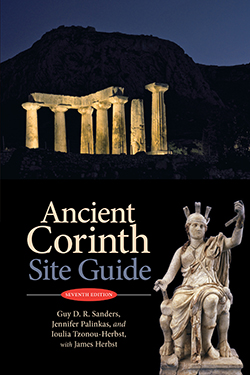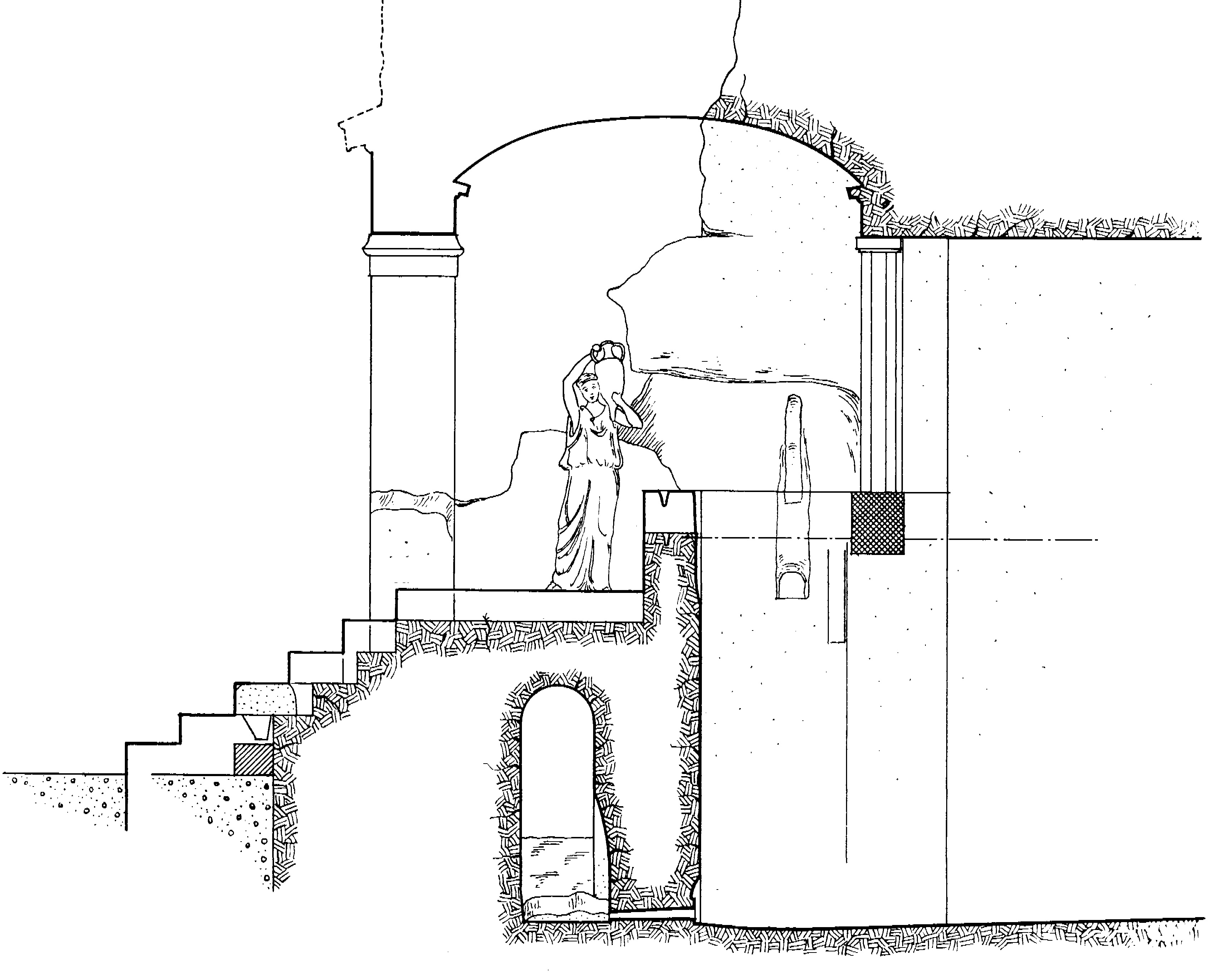Increasing Accessibility through the Ancient Corinth: Site Guide

Ancient Corinth: Site Guide is the first official guidebook to the site of ancient Corinth released by the American School of Classical Studies at Athens in over 50 years. The new publication comes fully updated with the most current information, color photos, maps, and plans making it an indispensable resource for the casual tourist or professional archaeologist new to the site. In preparation for its release, the four authors—Guy D. R. Sanders, former Director of Corinth Excavations, Jennifer Palinkas, instructor at Harford Day School in Maryland and excavator at the site, Ioulia Tzonou-Herbst, Associate Director of Corinth Excavations, and James Herbst, Architect of Corinth Excavations—discuss the guide and their hopes that it will increase the accessibility of Ancient Corinth.
Within the past few decades, interest in archaeology and its findings have called for improved accessibility to the most up-to-date information. “More and more, things are changing both in the way we do archaeology and the way the public has become involved,” said Ioulia Tzonou-Herbst, Associate Director of Corinth Excavations. “Previous archaeologists were so focused on producing research that maybe disseminating that research to a wider audience did not seem to be a priority. But now people are curious and want to know more.”
As demand for access to the latest information rises, disseminating finds and hypotheses from ancient Corinth has become exceptionally important to the School’s mission. Previously, most of this information was exchanged orally, as former excavation directors and museum staff provided tours to local guides. However, as a result, most often old research was regurgitated to visitors and books available in the town were produced by entities other than the American School. “It was great to see that people were making books for those interested in the archaeology of ancient Corinth, but the audience would not get the latest research. We needed to be involved if we also wanted to make known the work of the American School,” explained Tzonou-Herbst.
Filling this gap is the greatly anticipated Ancient Corinth: Site Guide. For the first time in many years, there is a guide to ancient Corinth written by the very people who have been excavating at the site. It is now available to the public through Casemate Academic (in the U.S.) and Oxbow Books (outside the U.S.), and it is hoped that the book will soon be available in the local shops at Corinth, as well.

The Temple of Apollo.
Ancient Corinth: Site Guide at its core realizes the ideals of making research publicly accessible, which was prioritized during author Guy Sanders’s tenure as Director of Corinth Excavations, 1997–2017. “During my time at Corinth, one of the things I tried to do is make the archaeological site, and its information, more democratic,” explained Sanders. “As archaeologists, we have been creating knowledge for each other, but we are only one of the stakeholders of the ancient world. There are thousands of people that come to this site every summer who don’t know what goes on in the basement and behind the scenes.” The creation of the Site Guide was just one aspect of this mission, and in fact grew out of earlier efforts.
Under Sanders, Corinth Excavations and museum staff digitized their collections, including objects and records, and grew a museum education outreach program, even taking the knowledge of the archaeological site across the world through virtual field trips. “We digitized the collections so that everybody could see what was locked away in drawers and in basements and also so that people would have access to our records,” said Sanders. “The text for the Site Guide developed out of this digitization program.”

Section through the porch of the Fountain of Glauke.
Building off that original text, the Site Guide began to take form. Jennifer Palinkas, who has been working at Corinth Excavations since the spring of 2002, joined the project to help transform the information into a usable site guide while James Herbst, Architect of the Corinth Excavations, compiled illustrations. “We pulled mostly from Charles Williams’s architectural drawings,” Herbst described. “Many of the drawings are from Corinth's archive and some are mine as well. However, the most work involved tailoring the labels for the Site Guide and its Greek translation.”
Deciding which information to include in the Site Guide also proved to be a challenge. “Site guides are inherently restrictive in that certain facts, dates, and descriptions need to be presented,” explained Tzonou-Herbst. “Corinth, however, is a complex site in terms of its length of occupation and its geomorphology. There is Greek, Roman, and Medieval material all mixed together, and visitors can really get lost in space. I think it’s very important, then, that we have an updated map so people can go from monument to monument and get concise information without feeling overwhelmed.” One of the principle attractions of the Site Guide is that it makes this important site’s complexity so approachable. It does so in part by including two large foldout maps in a pocket in the back, one of the site and its features and one of the area surrounding the ancient city and the features located there.
Dr. Guy Sanders and Dr. Ioulia Tzonou-Herbst. Photo: Moira Lavelle.
After introductory sections on the history of Corinth and the excavations conducted by the American School, Ancient Corinth: Site Guide leads visitors through two different Site Tours. Covering the fenced area of the site, the first tour begins at the museum, moving on to cover monuments such as the Temple of Apollo, the Forum, and the Fountain of Peirene. The second allows visitors to explore the ancient monuments outside the archaeological park, including the Odeion, the Theater, and the Asklepieion, and then the various remains of ancient Corinth located within and outside the ancient Greek walls, including the Sanctuary of Demeter and Kore and the Lechaion Basilica. To design the routes of the tours, Sanders and Palinkas let the crowd determine the way. “Jen and I walked around the site and observed where the tour groups went,” explained Sanders. “We didn’t create new paths but instead followed a circuit that seemed to be logical for how visitors were moving around Corinth.” Visitors are given detailed instructions throughout the guide so that they can easily follow both tours themselves.
Ending the Ancient Corinth: Site Guide are a selection of plans, a glossary, a list of publications, an index, and the two foldout maps. An additional section guiding visitors through the Archaeological Museum of Ancient Corinth was initially planned for this edition, but during the publication process, the museum displays changed. “The museum guide was not included because the permanent exhibition changed, causing the information to be outdated and out of context,” said Tzonou-Herbst. “There is a plan to produce a museum guide, and for me, it is very important to have one, so that visitors can marry objects in the museum with what is outside.”

Neolithic and Early Helladic pottery from Corinth.
Once the English text was complete, the Site Guide was translated to Modern Greek by Maria Michalarou and edited by Tzonou-Herbst. “There is always difficulty when you translate from one language to another,” explained Tzonou-Herbst. “However, in this case, I didn’t think anyone would have the English and Greek side-by-side, but, rather, they would just use them as individual books, so I pushed for a more free-flowing Greek translation.” With this intention, Tzonou-Herbst expressed her hope that the publication’s availability in Modern Greek would make it even more accessible to the local Greek community in Ancient Corinth. “I have had teachers approach me asking for articles to hand out to their students. Previously this included a very limited amount of publications in Greek. However, now with the Site Guide, hopefully local students educated about Ancient Corinth in high school will learn to love the area and, in their future life, grow an appreciation for archaeology and preserving Greece’s identity.”